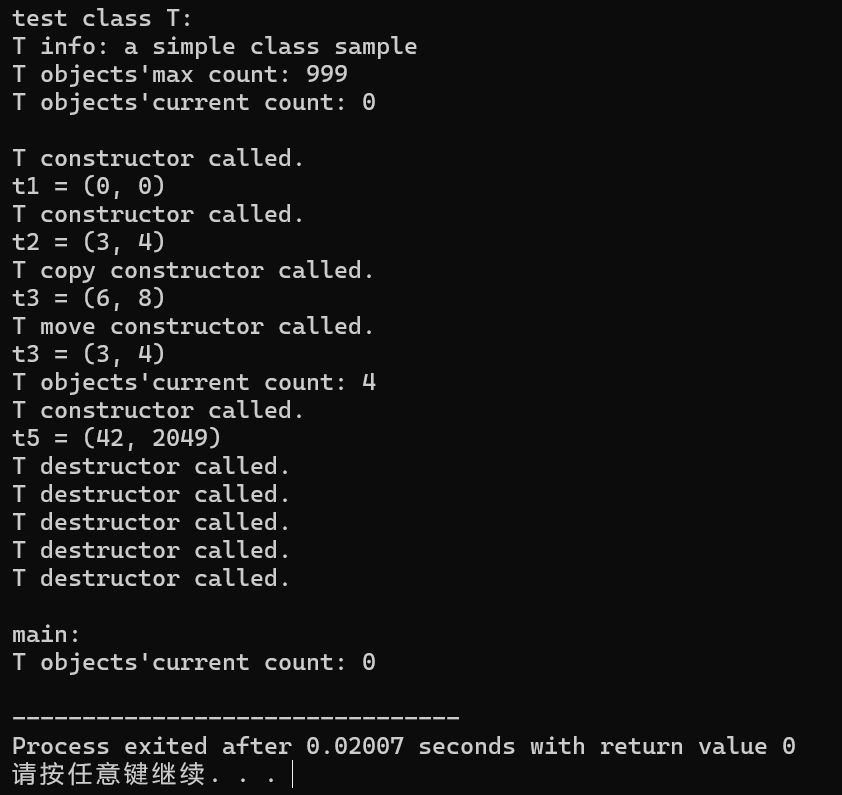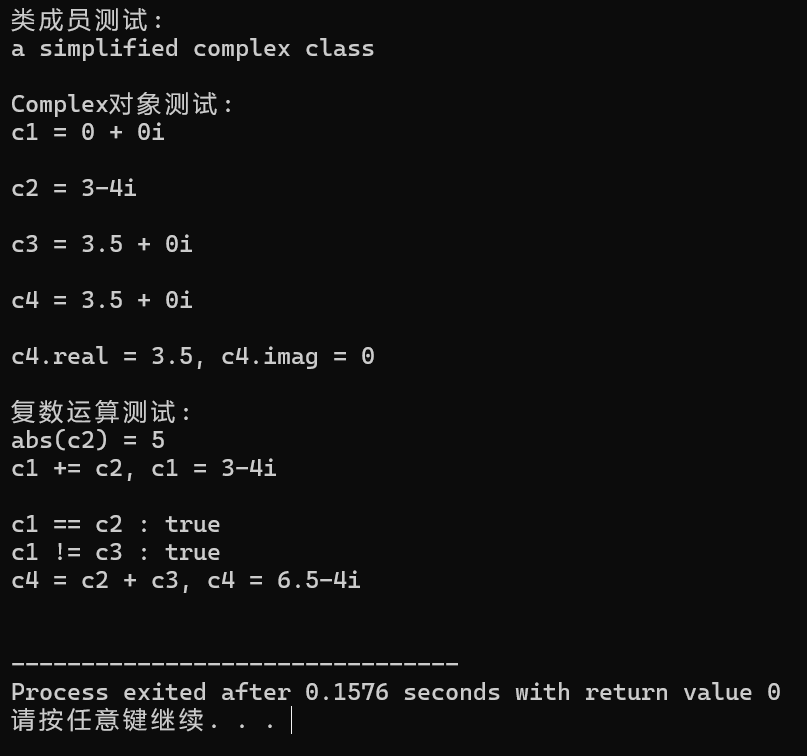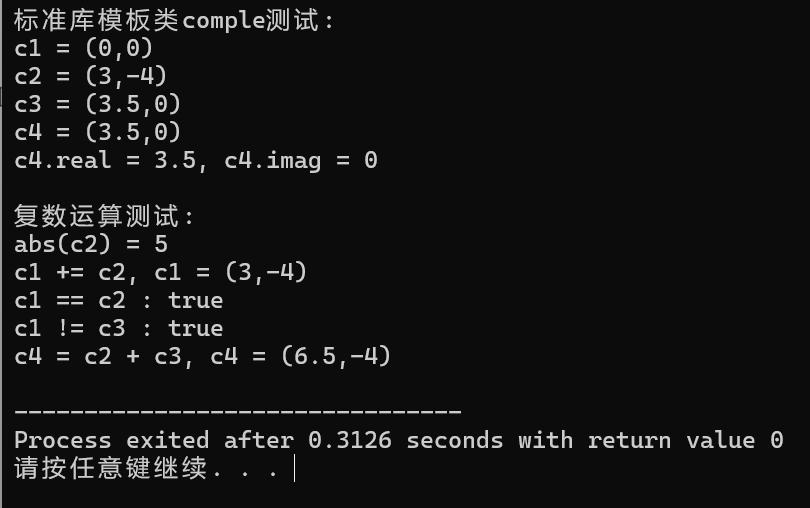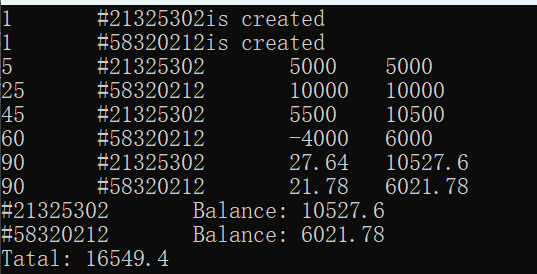实验2 类和对象_基础编程1
实验任务1
t.h源代码
// 类T: 声明
class T {
// 对象属性、方法
public:
T(int x = 0, int y = 0); // 普通构造函数
T(const T &t); // 复制构造函数
T(T &&t); // 移动构造函数
~T(); // 析构函数
void adjust(int ratio); // 按系数成倍调整数据
void display() const; // 以(m1, m2)形式显示T类对象信息
private:
int m1, m2;
// 类属性、方法
public:
static int get_cnt(); // 显示当前T类对象总数
public:
static const std::string doc; // 类T的描述信息
static const int max_cnt; // 类T对象上限
private:
static int cnt; // 当前T类对象数目
// 类T友元函数声明
friend void func();
};
// 普通函数声明
void func();
t.cpp源代码
// 类T: 实现
// 普通函数实现
#include "t.h"
#include <iostream>
#include <string>
using std::cout;
using std::endl;
using std::string;
// static成员数据类外初始化
const std::string T::doc{"a simple class sample"};
const int T::max_cnt = 999;
int T::cnt = 0;
// 对象方法
T::T(int x, int y): m1{x}, m2{y} {
++cnt;
cout << "T constructor called.\n";
}
T::T(const T &t): m1{t.m1}, m2{t.m2} {
++cnt;
cout << "T copy constructor called.\n";
}
T::T(T &&t): m1{t.m1}, m2{t.m2} {
++cnt;
cout << "T move constructor called.\n";
}
T::~T() {
--cnt;
cout << "T destructor called.\n";
}
void T::adjust(int ratio) {
m1 *= ratio;
m2 *= ratio;
}
void T::display() const {
cout << "(" << m1 << ", " << m2 << ")" ;
}
// 类方法
int T::get_cnt() {
return cnt;
}
// 友元
void func() {
T t5(42);
t5.m2 = 2049;
cout << "t5 = "; t5.display(); cout << endl;
}
task1.cpp源代码
#include "t.h"
#include <iostream>
using std::cout;
using std::endl;
void test();
int main() {
test();
cout << "\nmain: \n";
cout << "T objects'current count: " << T::get_cnt() << endl;
}
void test() {
cout << "test class T: \n";
cout << "T info: " << T::doc << endl;
cout << "T objects'max count: " << T::max_cnt << endl;
cout << "T objects'current count: " << T::get_cnt() << endl << endl;
T t1;
cout << "t1 = "; t1.display(); cout << endl;
T t2(3, 4);
cout << "t2 = "; t2.display(); cout << endl;
T t3(t2);
t3.adjust(2);
cout << "t3 = "; t3.display(); cout << endl;
T t4(std::move(t2));
cout << "t3 = "; t4.display(); cout << endl;
cout << "T objects'current count: " << T::get_cnt() << endl;
func();
}
运行测试结果截图:

问题1:能去掉line36
问题2:普通构造函数:在对象被创建时利用特定的值构造对象,将对象初始化为一个特定的状态。
复制构造函数:使用一个已经存在的对象,去初始化同类的一个新对象。
移动构造函数:受一个右值引用作为参数,并能够将资源从该引用转移到新创建的对象中。
与析构函数的调用时机:都是在对象的生存期即将结束的时刻被调用的。
问题3:不能
实验任务2
Complex.h
#ifndef COMPLEX_H
#define COMPLEX_H
#include <iostream>
#include <string>
#include <cmath>
using namespace std;
class Complex {
public:
static const string doc;
Complex(double x = 0, double y = 0) : real(x), imag(y) {}
Complex(const Complex &c);
double get_real() const {
return real;
}
double get_imag() const {
return imag;
}
void add(const Complex &c2);
friend Complex add(const Complex &c1,const Complex &c2);
friend bool is_equal(const Complex &c1,const Complex &c2);
friend bool is_not_equal(const Complex &c1,const Complex &c2);
friend void output(const Complex &c);
friend double abs(const Complex &c);
private:
double real;
double imag;
};
#endif
Complex.cpp
#include "Complex.h"
const std:: string Complex::doc = "a simplified complex class";
Complex::Complex(const Complex &c) : real(c.real) , imag(c.imag) {
}
void Complex::add(const Complex &c2){
real += c2.real;
imag += c2.imag;
}
Complex add(const Complex &c1,const Complex &c2){
return Complex(c1.real+c2.real,c1.imag+c2.imag);
}
bool is_equal(const Complex &c1,const Complex &c2){
if(c1.real == c2.real && c1.imag == c2.imag){
return true;
}else{
return false;
}
}
bool is_not_equal(const Complex &c1,const Complex &c2){
if(c1.real == c2.real && c1.imag == c2.imag){
return false;
}else{
return true;
}
}
void output(const Complex &c){
if(c.imag < 0){
cout << c.real << c.imag << "i" << endl;
}else{
cout << c.real << " + " << c.imag << "i" << endl;
}
}
double abs(const Complex &c){
return sqrt(c.real*c.real+c.imag*c.imag);
}
task2.cpp
#include "Complex.h"
#include <iostream>
#include <string>
using std::cout;
using std::endl;
using std::boolalpha;
void test() {
cout << "类成员测试: " << endl;
cout << Complex::doc << endl;
cout << endl;
cout << "Complex对象测试: " << endl;
Complex c1;
Complex c2(3, -4);
const Complex c3(3.5);
Complex c4(c3);
cout << "c1 = "; output(c1); cout << endl;
cout << "c2 = "; output(c2); cout << endl;
cout << "c3 = "; output(c3); cout << endl;
cout << "c4 = "; output(c4); cout << endl;
cout << "c4.real = " << c4.get_real() << ", c4.imag = " << c4.get_imag() << endl;
cout << endl;
cout << "复数运算测试: " << endl;
cout << "abs(c2) = " << abs(c2) << endl;
c1.add(c2);
cout << "c1 += c2, c1 = "; output(c1); cout << endl;
cout << boolalpha;
cout << "c1 == c2 : " << is_equal(c1, c2) << endl;
cout << "c1 != c3 : " << is_not_equal(c1, c3) << endl;
c4 = add(c2, c3);
cout << "c4 = c2 + c3, c4 = "; output(c4); cout << endl;
}
int main() {
test();
}
运行测试结果截图:

实验任务3
task3.cpp源代码
#include <iostream>
#include <complex>
using std::cout;
using std::endl;
using std::boolalpha;
using std::complex;
void test() {
cout << "标准库模板类comple测试: " << endl;
complex<double> c1;
complex<double> c2(3, -4);
const complex<double> c3(3.5);
complex<double> c4(c3);
cout << "c1 = " << c1 << endl;
cout << "c2 = " << c2 << endl;
cout << "c3 = " << c3 << endl;
cout << "c4 = " << c4 << endl;
cout << "c4.real = " << c4.real() << ", c4.imag = " << c4.imag() << endl;
cout << endl;
cout << "复数运算测试: " << endl;
cout << "abs(c2) = " << abs(c2) << endl;
c1 += c2;
cout << "c1 += c2, c1 = " << c1 << endl;
cout << boolalpha;
cout << "c1 == c2 : " << (c1 == c2) << endl;
cout << "c1 != c3 : " << (c1 != c3) << endl;
c4 = c2 + c3;
cout << "c4 = c2 + c3, c4 = " << c4 << endl;
}
int main() {
test();
}
运行测试结果截图:

启发:要多运用标准库中的模板类,这样可以大大减少代码的复杂程度,简化代码的同时也方便读者理解
实验任务4
Faction.h
#pragma once
#include <string>
using namespace std;
class Fraction{
public:
static const string doc;
static int gcd(int a,int b);
static Fraction simplify(Fraction result);
Fraction(int u = 1,int d = 1);
Fraction(const Fraction &f);
Fraction negative() const;
int numerator() const;
int denominator() const;
friend void output(const Fraction &f);
friend Fraction add(const Fraction &f1,const Fraction &f2);
friend Fraction sub(const Fraction &f1,const Fraction &f2);
friend Fraction mul(const Fraction &f1,const Fraction &f2);
friend Fraction div(const Fraction &f1,const Fraction &f2);
private:
int up;
int down;
};
Fraction.cpp
#include "Fraction.h"
#include <iostream>
#include <string>
#include<cstdio>
using std::cout;
using std::endl;
using std::string;
const std::string Fraction::doc{"Fraction类 v 0.01版.目前仅支持分数对象的构造、输出、加/减/乘/除运算."};
int Fraction :: gcd(int a, int b){
return !b ? a : gcd(b, a%b);
}
Fraction Fraction :: simplify (Fraction result){
if(result.down < 0){
result.up = - result.up;
result.down = - result.down;
}
if(result.up == 0){
result.down = 1;
}else{
int d = gcd(abs(result.up), abs(result.down));
result.up /= d;
result.down /= d;
}
return result;
}
Fraction :: Fraction (int u,int d): up(u) , down(d) {}
Fraction :: Fraction (const Fraction &f) : up(f.up),down(f.down){}
Fraction Fraction :: negative() const {
return Fraction(-up,down);
}
void output(const Fraction &f){
if(f.up == 0){
cout << 0;
}else if(f.down == 0){
cout << "分母不能为零" << endl;
}else if(f.down == 1){
cout << f.up;
}else {
Fraction t;
t = Fraction :: simplify(f);
cout << t.up << "/" << t.down;
}
}
int Fraction::numerator() const {
return up;
}
int Fraction::denominator() const {
return down;
}
Fraction add(const Fraction &f1,const Fraction &f2){
int new_up = f1.up * f2.down + f2.up * f1.down;
int new_down = f1.down * f2.down;
return Fraction(new_up, new_down);
}
Fraction sub(const Fraction &f1,const Fraction &f2){
int new_up = f1.up * f2.down - f2.up * f1.down;
int new_down = f1.down * f2.down;
return Fraction(new_up, new_down);
}
Fraction mul(const Fraction &f1,const Fraction &f2){
int new_up = f1.up * f2.up;
int new_down = f1.down * f2.down;
return Fraction(new_up, new_down);
}
Fraction div(const Fraction &f1,const Fraction &f2){
int new_up = f1.up * f2.down;
int new_down = f1.down * f2.up;
return Fraction(new_up, new_down);
}
task.cpp
#include "Fraction.h"
#include <iostream>
using std::cout;
using std::endl;
void test1() {
cout << "Fraction类测试: " << endl;
cout << Fraction::doc << endl << endl;
Fraction f1(5);
Fraction f2(3, -4), f3(-18, 12);
Fraction f4(f3);
cout << "f1 = "; output(f1); cout << endl;
cout << "f2 = "; output(f2); cout << endl;
cout << "f3 = "; output(f3); cout << endl;
cout << "f4 = "; output(f4); cout << endl;
Fraction f5(f4.negative());
cout << "f5 = "; output(f5); cout << endl;
cout << "f5.get_up() = " << f5.get_up() << ", f5.get_down() = " << f5.get_down() << endl;
cout << "f1 + f2 = "; output(add(f1, f2)); cout << endl;
cout << "f1 - f2 = "; output(sub(f1, f2)); cout << endl;
cout << "f1 * f2 = "; output(mul(f1, f2)); cout << endl;
cout << "f1 / f2 = "; output(div(f1, f2)); cout << endl;
cout << "f4 + f5 = "; output(add(f4, f5)); cout << endl;
}
void test2() {
Fraction f6(42, 55), f7(0, 3);
cout << "f6 = "; output(f6); cout << endl;
cout << "f7 = "; output(f7); cout << endl;
cout << "f6 / f7 = "; output(div(f6, f7)); cout << endl;
}
int main() {
cout << "测试1: Fraction类基础功能测试\n";
test1();
cout << "\n测试2: 分母为0测试: \n";
test2();
}
运行测试结果截图:

实验任务5
account.h
#ifndef __ACCOUNT_H__
#define __ACCOUNT_H__
class SavingAccount
{
private:
int id;
double balance;
double rate;
int lastDate;
double accumulation;
static double total;
void record(int date, double amount);
double accumulate(int date) const {
return accumulation + balance * (date - lastDate);
}
public:
SavingAccount(int date, int id, double rate);
int getId()const { return id; }
double getBalance()const { return balance; }
double getRate() const { return rate; }
static double getTotal() { return total; }
void deposit(int date, double amount);
void withdraw(int date, double amount);
void settle(int date);
void show() const;
};
#endif
account.cpp
#include "account.h"
#include <cmath>
#include <iostream>
using namespace std;
double SavingAccount::total = 0;
SavingAccount::SavingAccount(int date, int id, double rate) :id(id), balance(0), rate(rate), lastDate(date), accumulation(0)
{
cout << date << "\t#" << id << "is created" << endl;
}
void SavingAccount::record(int date, double amount)
{
accumulation = accumulate(date);
lastDate = date;
amount = floor(amount * 100 + 0.5) / 100; //保留小数点后两位
balance += amount;
total += amount;
cout << date << "\t#" << id << "\t"<<amount<<"\t"<<balance << endl;
}
void SavingAccount::deposit(int date, double amount)
{
record(date, amount);
}
void SavingAccount::withdraw(int date, double amount)
{
if (amount > getBalance())
{
cout << "Error: not enough money" << endl;
}
else
{
record(date, -amount);
}
}
void SavingAccount::settle(int date)
{
double interest = accumulate(date) * rate / 365;
if (interest != 0)
{
record(date, interest);
}
accumulation = 0;
}
void SavingAccount::show() const
{
cout << "#" << id << "\tBalance: " << balance;
}
5_11.cpp
#include "account.h"
#include <iostream>
using namespace std;
int main()
{
SavingAccount sa0(1, 21325302, 0.015);
SavingAccount sa1(1, 58320212, 0.015);
sa0.deposit(5, 5000);
sa1.deposit(25, 10000);
sa0.deposit(45, 5500);
sa1.withdraw(60, 4000);
sa0.settle(90);
sa1.settle(90);
sa0.show(); cout << endl;
sa1.show(); cout << endl;
cout << "Tatal: " << SavingAccount::getTotal() << endl;
return 0;
}
运行测试结果截图:

目前教材上的接口和类内部的计算模块还是比较合理的,我认为计算模块还需要改进:
- 账户余额的计算要更准确。例如,存款后余额是否增加,取款后余额是否减少,且不会出现负数余额的情况。
- 舍去不必要的复杂算法或数据结构,避免性能下降



